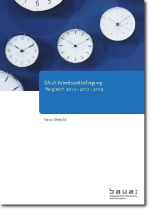BAuA Working Time Survey: Comparison 2015 - 2017 - 2019
(in German)
During the SARS-CoV-2 pandemic, the working conditions of many employees have changed dramatically. First changes in working hours or working from home have already been reported. The present report focuses on the status quo before the pandemic and gives an overview of the organization of working times with regard to the duration, location and flexibility of working times in 2019. In addition, the report takes into account the aspect of telework and home office. The results of the BAuA Working Time Surveys 2015, 2017 and 2019 are combined to describe trends and changes. An excursus also focuses on the working time pattern of employees in so-called "systemrelevant occupations".
The results show that the overall duration of working time has hardly changed, with parttime employees working slightly longer and full-time employees on average working slightly shorter hours. Particularly noticeable is an increasing demand for shorter working hours. The working time location, i. e. atypical working hours such as shift or night work and work at weekends, has not changed. On the other hand, an increase in the working time control of employees can be observed in 2019. Compared to 2015, the spread of working time accounts has also increased. Already before the SARS-CoV-2 pandemic a continuous increase of teleworking or home office could be observed over the three survey periods. The working time patterns of the employees in system-relevant occupations are characterized by atypical working time locations, high demands on flexibility and on-call work, shortened rest periods and a low level of working time control. This will be discussed in detail against the background of stressful working conditions during the SARS-CoV-2 pandemic.
All in all, it can be seen that a large number of working conditions are stable. However, an increasing number of full-time employees would like to have shorter working hours. Since it can be assumed that the SARS-CoV-2 pandemic will have a lasting effect on working hours in Germany, the BAuA-Time Survey will monitor working hours during and after SARS-CoV-2 in more detail. To this end, this report will discuss initial findings and hypotheses on the long-term effects of the pandemic.
Please download the complete report "BAuA Working Time Survey: Comparison 2015 - 2017 - 2019" (in German only).
Bibliographic information
Title: BAuA-Arbeitszeitbefragung: Vergleich 2015 - 2017 - 2019.
1. edition.
Dortmund:
Bundesanstalt für Arbeitsschutz und Arbeitsmedizin, 2020.
ISBN: 978-3-88261-734-4, pages: 105, Project number: F 2452, paper, PDF file, DOI: 10.21934/baua:bericht20201217


